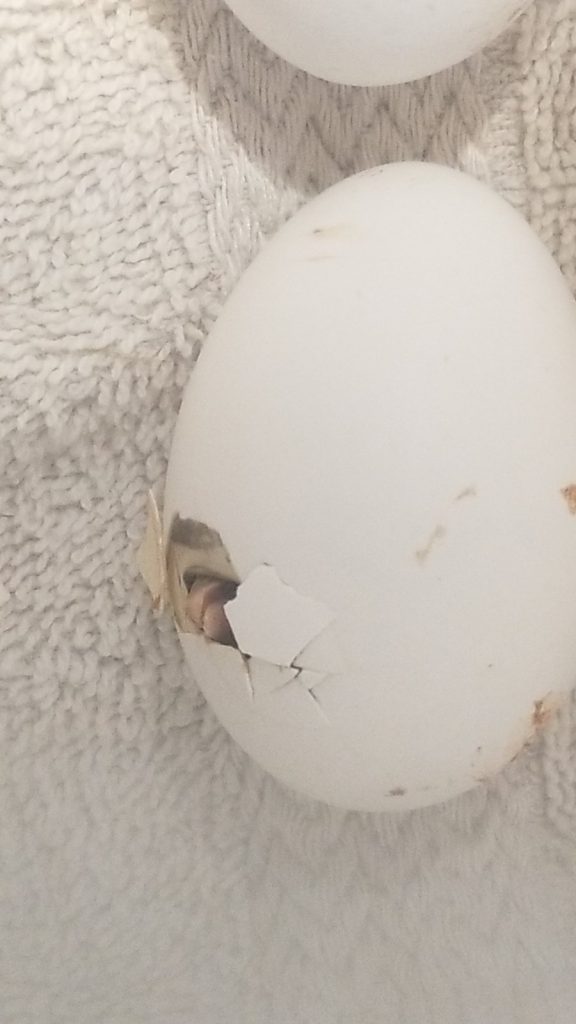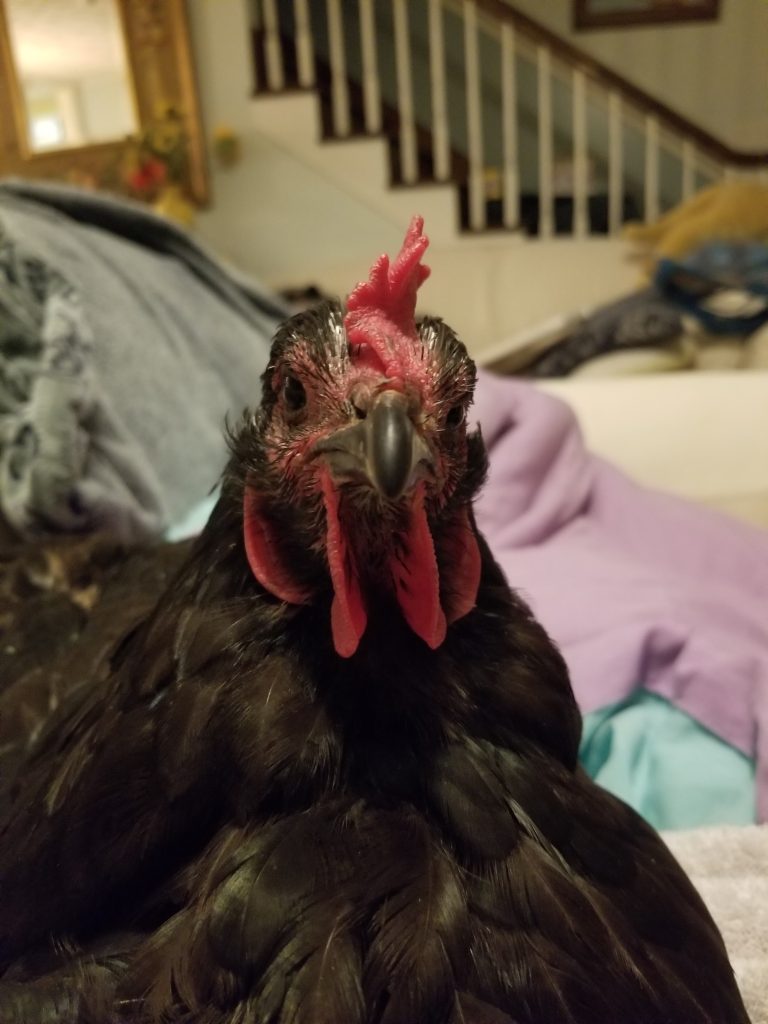We’re learning why not to count your chickens before they hatch. Unlike Aesop’s daydreaming chicken farmer, we’re being fairly thoughtful about how we’re handling our eggs. And, to be sure, we’re getting better at all of this. But, hatching chickens is not foolproof.

Back Story
The first box of chickens at this place was imported in 2017 but our experience with hatching chickens from home grown eggs has been “mixed”. In a general way, chickens are part of the entertainment, landscaping, sound track and food source here. By “here” we mean the Firefly, bed and breakfast near Madison GA.
Chicken Hatching Project
There are always projects here of one kind or another. In this case, it came to our attention that we need to renew the flock occasionally. Chickens optimally lay eggs for about three years. After that, they mainly walk around and eat. We have only a rough idea at this point of which of the chickens were the immigrants, and which have arrived since.
So, to keep the flock fresh, we have to have a process of renewal. That is, of course, except for Weezy, who despite some recent trauma is still hanging in there at about Age 6, and giving us an egg occasionally.
Also it came to our attention that the black market price of laying chickens has reached $40 per bird.
So, in order to enhance the net worth of the place, it made sense to try to incubate and pump up the flock by trying to hatch some chickens this year.
Chicken Economics
The local rate for black market eggs in the area is $5 per dozen, or 41 cents an egg. The rate for baby chicks, of the type you hold in your hand around Easter time is about $4. You can pick these up from the Tractor Supply and also various places around the area.
It takes about 6 months to get from hatching to laying, according to Meyer Hatchery.
But, assuming you do hatch a hatchling, you can’t just send it out with the rest of the flock. Like all political organizations there is a pecking order, and the little ones get picked on. Also, the dogs like to play with them. So, there needs to be a brooding cage until they get big and fast enough to take care of themselves, which takes maybe six weeks.
We’ll go over the timeline in a minute. For now we’re focused on cost.
Here’s a table
| Event | Cost | Cost Extension | Total |
| Collect Eggs | 50 cents per egg | .50X1 | .41 |
| Incubate | incremental energy cost (negligible) | 0 | |
| Chick Starting | Six weeks at an average of 2 ounces per day of chick starter $25 per 50 pound bag | 45*.03 | 1.46 |
| Feeding | 12 weeks at an average of 4 ounces of chicken feed per day, $25 for 50 pound bag | 135*.03 | 4.05 |
| Sub Total | 5.92 | ||
| Rooster Ratio | 50/50 | X2 | |
| Total Cost (excluding fixed costs) | $11.84 |
Explanation
Okay then, we’re assuming that if you collect an egg, it’s costing you the opportunity to eat it. We’re assigning an opportunity cost of $0.41 per egg, since that’s the local black market price.
We’re also assuming you are buying chicken feed at Tractor Supply. The above totals are for “normal” chicken feed. At this place, you can get “boutique” chicken feed for much more than that. Also, if you go uptown to the feed store, you can probably do better cost-wise.
Also, since chickens eat whatever you throw at them, you can supplement this a little if you have sources of food, which might include table scraps and dumpster diving.

The Rooster Ratio
According to the people that do this for a living, despite generations of selective breeding, 50% of the birds that hatch are going to be roosters.
People will actually drive up the driveway and give us roosters. They eat, fight, and make a lot of noise. They don’t compensate you for your time and effort. Since we don’t really like peeling them and eating them, their value is mainly aesthetic. Multiple roosters can also have a negative effect on group dynamics.
So whatever it costs you to hatch and raise a chicken, 50% of them aren’t going to be valuable to you, so your costs essentially double.
Alternative to Hatching
Our regenerative farming hero, Justin Rhodes, gets his chickens from McMurray Farm, which is in the state of Eggland.
This place has organically raised chickens of about a dozen breeds. You can order a lot of these and have them delivered locally.
Here’s the pricing on “Andalusians” which are better known as “white chickens.” Chickens can be bought as male, female, or “unsexed.” Since some people have no problem eating their roosters, there’s still a market for 100% Male ones.
But, for “sexed” female ones, and “unsexed” which are essentially 50/50 male and female, they’re sold out.

Conspiracy Theory
We’ve thought about this too. There is an ongoing issue with the bird flu, particularly up in Eggland. A year or two ago they had to do away with millions of chickens because of it. In this land, a USDA inspector can go onto your land, determine that your flock has it, and have it euthanized. This is enormously traumatic for the farmer, as it would be for us.
Whether or not you think this is a “good thing” is suitable for a friendly debate. We volunteer to host this debate, complete with adult beverages, and claim the video rights.
To make a long story short, at some point in the past, “the government” became empowered to confiscate a farmer’s herd/flock/crop of whatever livestock or plant, and either quarantine it or have it eliminated and buried in order to stop the spread of diseases which “could” decimate the food supply.
When did this happen? Well it was all because of that do-gooder George Washington, who signed the law in 1792. At that point it was assumed to be a government responsibility to keep you from killing every chicken in the state by having a contaminated flock, and transporting it.
We will save the commentary on this for the time being.
Why Not to Count Your Chickens Before They Hatch
There’s another thing to think about, which is that they don’t all hatch. Sometimes despite the attention of the roosters, the eggs we collect aren’t fertile, or for whatever other reason don’t make it. In a way this increases your opportunity cost as well. If you collect an egg, there’s a significant chance that it won’t hatch.
We’ll share our experiences with the hatching process itself in part 2, of this, but suffice it to say that it is not without risk. in the meantime, based on this calculation, there’s a little bit of a profit to be made, for people who are into this sort of thing.
What this experience has done is give us some respect for the people who really do this for a living. They have all sorts of risks and perils. I guess that’s another reason for the project, to give us respect for the people who do it for a living.
Stay tuned for Part 2.
Links and References
How long between hatching and laying
Chicken Feed Per Day
Tractor Supply chick starter
Tractor Supply Layer Feed
https://www.tractorsupply.com/tsc/product/nutrena-naturewise-layer-16-crumbles-50-lb?cm_vc=-10005
Ratio of Hens to Roosters
McMurray Farms
https://www.mcmurrayhatchery.com/index.html
George Washington
https://blogs.loc.gov/law/2020/12/plant-and-animal-quarantining-in-united-states-legal-history/
PS We’re still pretty terrified of the Georgia Food Safety Law, which has in a lot of unintended circumstances.
Here’s our previous blog post on this:
![]()
